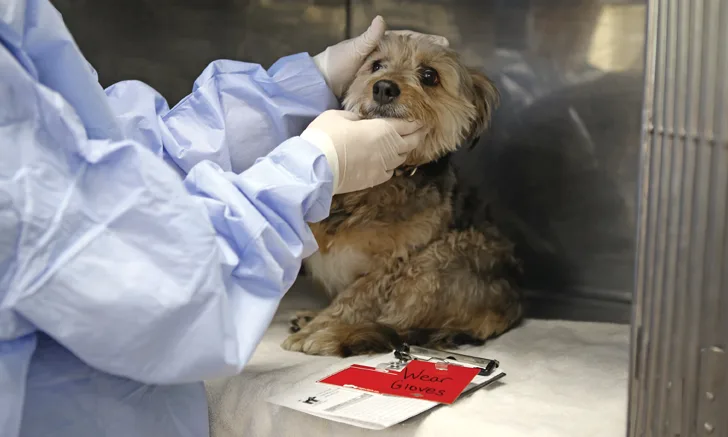Protecting the Immunocompromised Patient
Carrie Jo Anderson, MS, CVT, Hillsborough Community College

Varying levels of immunosuppression may be present in veterinary patients as primary or secondary (ie, inherited or acquired) immunodeficiency, sequelae of an ongoing disease process, or a consequence of treatments to fight a disease. In the last instance, the case may be an intentional suppression of the immune system, an adverse effect, or an existing secondary infection.
Regardless of the cause, immunocompromised patients are more susceptible to infection by opportunistic pathogens present in the environment, in the veterinary practice, or on veterinary team members. Practice protocols should be designed to protect not only immunosuppressed patients that may be infectious and therefore kept in isolation, but also patients in the general practice population that may be immunodeficient.
Immunocompromised patients require many special considerations.
Related Article: Biosurveillance: How to Monitor Disease Trends
Definitions1
Cage-Side
These patients should have clearly marked indicators on their treatment sheet and cage card. Even if regular protocols are in place, patient condition reminders are necessary and essential to good nursing care.
Team members should always use a dedicated thermometer and fresh examination table cover, and wear fresh gloves and gown. Sharing a thermometer and/or examination table cover with other patients exposes them unnecessarily, and even though gloves should be worn when handling any patient, having some readily accessible at the cage is useful in an emergency.2
Immunocompromised patients should always be given food from an unopened can and not stored food from a previously opened can.
Treatment Area
These patients should not be loose or even tethered in the general treatment area.
All team members must wash their hands between patient examinations, treatments, and handling2—a universal precaution that must be taken in every veterinary practice.2
Team members should also wear gloves whenever they examine or perform procedures or diagnostic tests on these patients. They can also wear sterile gowns or aprons to prevent exposure to debris or discharge on their clothing from other patients they may have handled.2
Aseptic technique and practice-specific protocols related to infection control must be strictly followed, including placing and maintaining IV or urinary catheters, placing feeding or oxygen tubes, and securing diagnostic specimens.
Related Article: Safety Protocols in Practice
Immunocompromised patients should always be recovered in their dedicated cage and not a communal recovery area.
Equipment
Practice protocols regarding invasive lines and tubes must be strictly followed with immunocompromised patients, including aseptic technique, IV placement and handling protocols, urinary and arterial catheters, indwelling tubes (eg, JP drains, chest tubes, feeding tubes), and practice longevity rules.2
All practices should adopt specific medical device protocols for diagnostic and therapeutic work with immunocompromised patients, including dedicated patient equipment (eg, new or sterilized otoscope cones, nail clippers, clipper blades) and monitor leads (eg, blood pressure cuffs, pulse oximetry leads, thermometers, extended temperature probes).
When immunocompromised patients need to undergo general anesthesia, specific microorganism exposure routes should be anticipated and prevented.2 Team members should use new or sterilized equipment wherever possible, including laryngoscope blades, endotracheal tubes, breathing circuits, and patient monitor leads (eg, EKG, EtCO2, SpO2, direct and indirect blood pressure, temperature probes).2
Related Article: Examination Room Do's & Don'ts
In Recovery
Patients recovering from sedation or anesthetic procedures should be returned to their dedicated cage and not placed in a communal recovery or treatment area.
Clean bedding and blankets should always be provided.
At Home
Team members should provide clients with customized information that will help them care for and protect their pet at home.
Helping Clients with Immunocompromised Pets
When a pet is identified as immunodeficient or immunocompromised, his or her immune system is less effective than usual, making him or her more susceptible to infection than a healthy pet. However, precautions can be taken to protect the pet from exposure to parasites and microorganisms that may cause a dangerous infection. Following are some of these precautions.
Do:
Keep cats indoors while their immune system is compromised. Keep dogs confined to the immediate yard or walking area to reduce exposure to other animals or infectious agents. Ask the veterinarian to recommend a specific duration (usually the length of illness or treatment).
Keep giving the pet any external and internal parasite prevention (eg, flea, tick, heartworm, intestinal) recommended by the veterinarian. Parasitic infestations are not only dangerous but many external parasites can also carry bacterial, protozoal, or viral microorganisms that can cause disease.
Keep track of and adhere to vaccination protocol adjustments the veterinarian makes for the dog or cat based on his or her immune system status.
Do Not:
Introduce new animals to the household while the pet is immunocompromised, if at all possible. Ask visiting family members to leave their pets at home.
Take the pet to a day-care facility, dog park, or pet store where contact with other animals is possible.
Let the pet play in or drink from communal outdoor water sources (eg, fountains, ponds, rivers).
Related Article: Crucial Client Conversations: Pets with Chronic Conditions
Conclusion
Immunocompromised veterinary patients are at risk for infection from agents encountered in the environment, the practice, and during direct contact with team members. This risk can be minimized, however, with a safety and infection control protocol.
Veterinary team members should explore the above options, critically examine their practice for potential patient exposure or protocol breakdowns, and ensure clients are equipped to protect their pets once they return home.